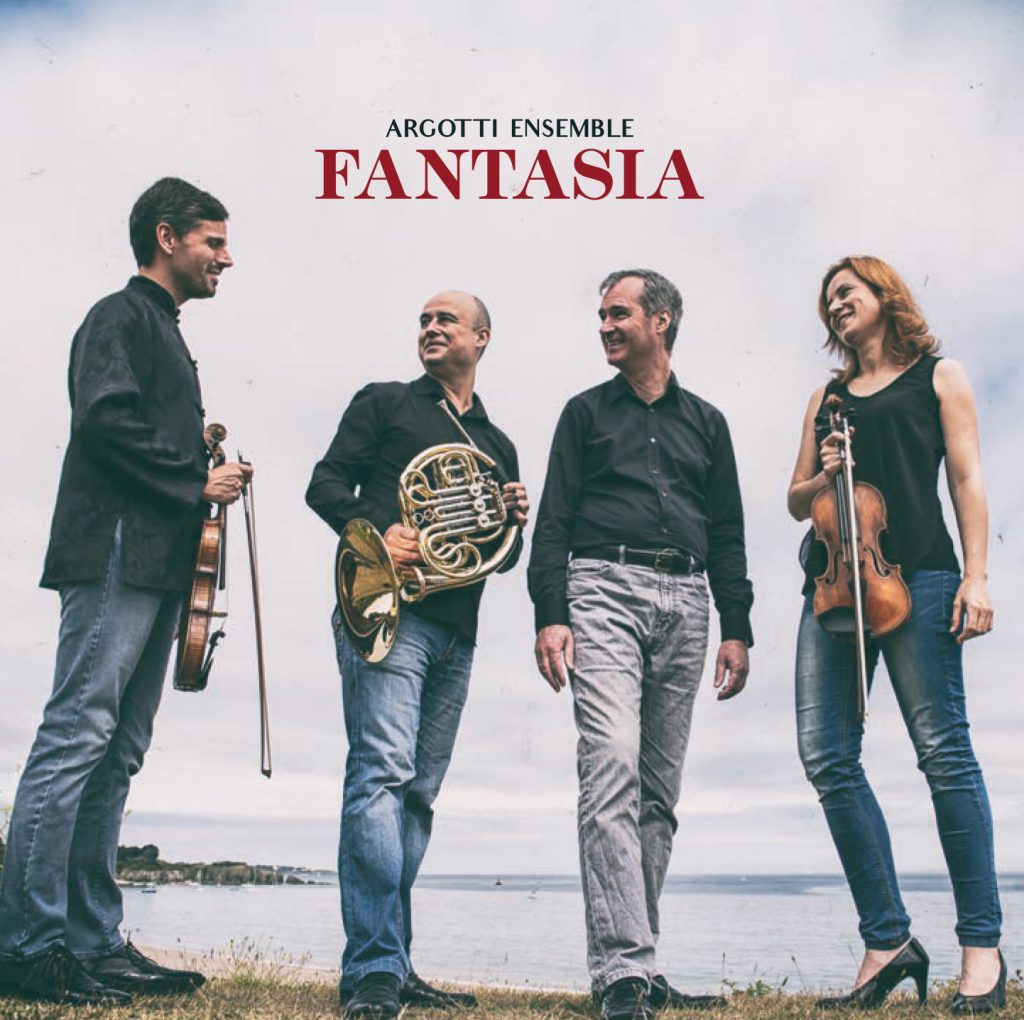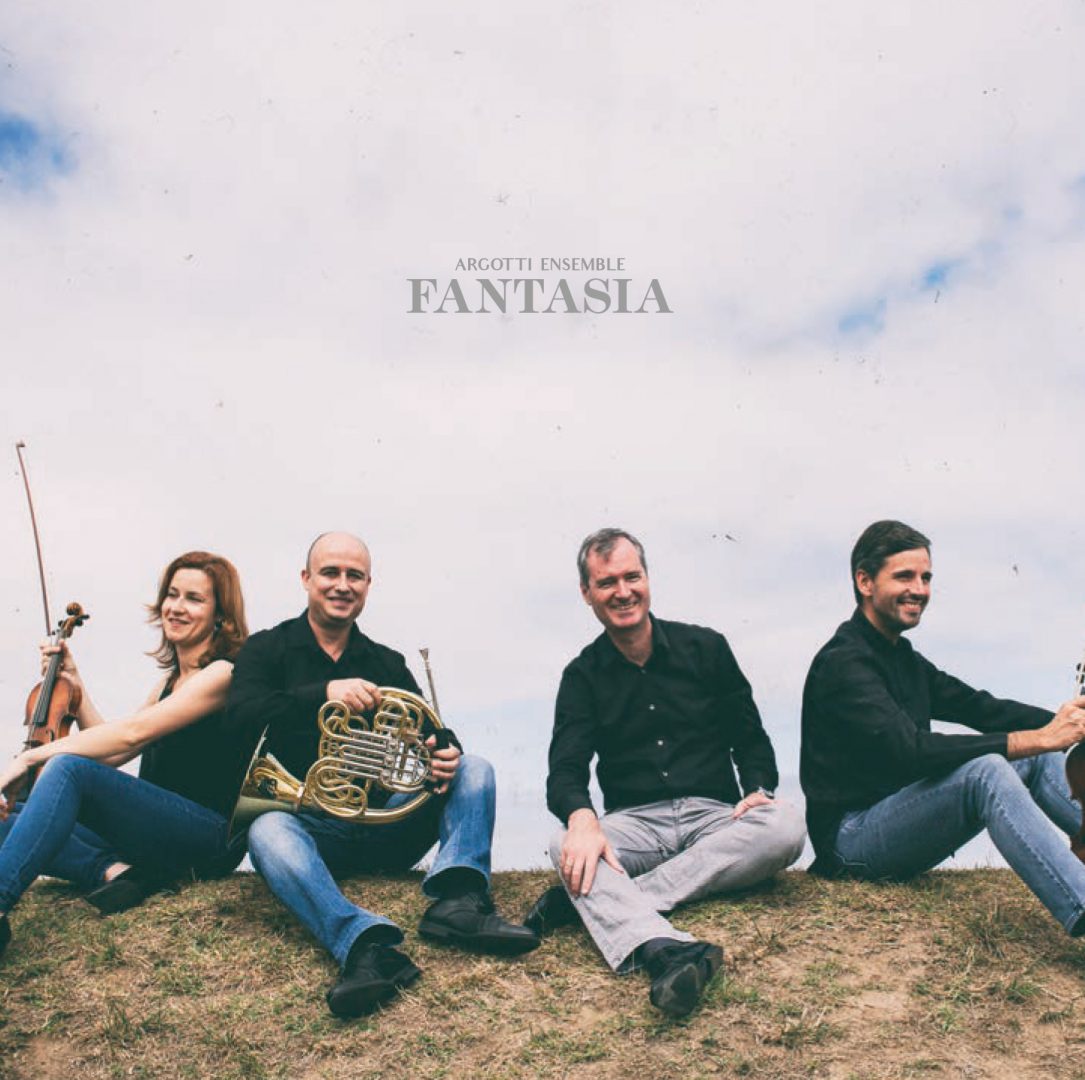ARGOTTI ENSEMBLE FANTASIA
Maria Conrad / violin
Nemanja Ljubinkovic / violin
José García Gutiérrez / Horn
Philip Walsh / piano
The Argotti Ensemble was formed in 2012 by four international musicians all having close ties to Malta. All of them are passionate about performing chamber music and it was with this intention that they created a flexible formation ranging from duo to chamber orchestra.
Over the last six years the ensemble has given successful concerts throughout Europe and has premiered several works written specially for them, notably by Maltese composers. Among the ensemble’s members are active soloists, following busy schedules as freelance orchestral musicians with some of the leading symphony and chamber orchestras across the globe.

Robert Schumann (1810-1856)
Adagio and Allegro, op.70
Robert Schumann’s Adagio and Allegro dates from 1849, one of his most productive years during which he was in good health and spirits. Schumann was a strong supporter of the recently-invented valve-horn which began appearing only some 15 years earlier and his compositions looked more towards the possibilities of this instrument than to what was actually available at this time.
The two movements that make up this piece are full of optimism and good cheer. The conversational Adagio recalls the lyrical elements of Schumann’s songs, while the Allegro, written in rondo form, offers a dazzling technical display in the first and last sections with persistent triplets recalling the hunting horn, alternating with a more lyrical and poetic episode based on the opening Adagio. Although the solo part was also transcribed by the composer for violin, viola or cello, the horn version has always been the most popular and was in fact the work that would inspire Schumann to compose the Konzertstück soon after.
Mortiz Moszkowski (1854-1925)
Suite for two violins and piano, op.71
Allegro energico – Allegro moderato – Lento assai – Molto vivace
Of Polish descent, German pianist and composer Moritz Moszkowski enjoyed huge success at the turn of the 20th century. Mostly admired for his lighter works, particularly his piano and chamber compositions, the Suite is one of his most significant compositions. Featuring a remarkable balance not only between the three instruments, but also between the flashy, technical brilliance and the solid command of counterpoint, the various passages of extensive double-stopping at times almost suggest the texture of a piano quartet. In this piece Moszkowski, known for his sense of humour, contrasts beautifully the light, comical elements with the more intense lines.
The sonata and rondo forms of the energetic first movement give way to the two inner movements, which reveal the move intimate Moszkowski. Here the sentimental Allegro Moderato merges into the intricate melodic counterpoint of the Lento assai before coming to a close with a spectacular tarantella.
Alex Vella Gregory (b.1984)
Sonata Sopra Agnus Dei
This composition, written for the ensemble, is built around the painting of “Our Lady of the Rosary” by Maltese Baroque composer Francesco Zahra. Surrounding the figure of the Virgin and the infant Jesus (The “Agnus Dei”) are 15 medallions representing the 15 mysteries of the Hylo Rosary, and balancing all of this is a triangular effect created between the figures of the Virgin, St. Dominic and St. Catherine of Siena.
Musically, the work uses similar calculations, with each instrument representing a different element – the piano being the Virgin, the horn representing Christ, while the two violins represent St. Domonic and St. Catherine. Similar to the painting, the piano is the dominant figure. Divided into three sections, each represents a set of mysteries containing 5 subsections, made up of 12 bars reflecting the 12 players of each mystery. The title refers to a short Mass with a threefold structure composed previously by Vella Gregory, who in this work uses the baroque concept of “sonata” over a pre-existing tune.
The first set (Gaudiosa) is for piano solo and presents a very calm, almost static, atmosphere. These mysteries reflect on the geneses of the story of salvation, with Mary playing a central role. The music is built on canonic procedures and triadic harmony, producing a meditative quality. The second set (Dolorosa) introduces the horn and reflects on the Passion narrative. Dramatic and emotional, they feature mayny musical symbols incorporated into the music, such as the chordal ‘lashes for the flagellation episode, which then become seven musical ‘sighs’ in the crucifixion section symbolising Christ’s seven last words.
The final part introduces the two violins. The glorious mysteries reflect on Christ’s ministry and the promise of eternal salvation and here the music is built on fugal textures with a fugal subject built on the accompaniment taken from the original Agnus Dei. All the various elements come together in the final vision of heavenly glory, symbolised by the last mystery celebrating Mary being crowded by the Holy Trinity as queen of Heaven and Earth.
Joseph Vella (1942-2018)
Fantasia for two violins, horn and piano, op.154
The imaginative and rhapsodic mood of the fantasia comes out mostly in the dialogic, playful exchange between the various instruments. Beneath the sense of improvisation typical of this type of work lies an inscrutable logic evident in the inimitable contrapuntal patterns employed by the composer. There is a paradoxical lyricism in atonality and an urge to dwell on a tonal centre, yet without actually ever settling on one. The harmonic structures towards the end appear to career seemingly aimlessly but show a concentrated yet easeful effort at resolution rather than dissolution.
This composition, written specially by Vella with the ensemble in mind, turned out to be the composer’s last complete work in this long and prolific career. Having known all members personally for many years, he knew exactly what he wanted to write for each on in their particular line. New, fresh and ageless, with a luminous texture, there is nothing in the mood, style, texture or ideas that foretells any foreboding or tragedy, but attests to his creativity and inventiveness, exploiting as always the limits of melodic and harmonic writing.
Gabriel García Martínez (b.1945)
Apocalipsis
Based on the apocalyptic prophecies of the readings of the Book of Revelation by St. John, this work, composed by Spanish horn pedagogue Gabriel García Martínez reflects the symbolism of these writings. In particular it features the figures of the four horsemen symbolizing Conquest, War, Famine and Death. The two instruments alternate to express the grand, dramatic but also serene element of this clearly descriptive work which explores the technical possibilities of the horn to the utmost and together with a strongly supportive piano accompaniment bring out through the music the intensity and suspense of these dramatic texts.

Reinhold Glière (1875-1956)
Four pieces for horn and piano, op.35
Nocturne – Intermezzo – Romance – Valse Triste
Russian composer Reinhold Glière was a direct heir to the Russian romantic tradition, and worked extensively on large forms such as symphony, ballet and opera. What stands out most in his music are the wonderfully expressive melodies which are particularly apparent in his solo horn compositions. His horn concerto was composed for Valeri Polekh, who declared that Glière had the idea of treating the horn as a virtuoso instrument, almost like a violin. The four pieces require rather than a technical virtuosity a much more intrinsic expression and beautiful lyrical line. Originally forming part of a larger body of work containing 11 pieces featuring flute, clarinet, bassoon and oboe apart from the horn, these pieces are staples of their corresponding instrumental repertoire.
Dmitri Shostakovich (1906-1975)
Five pieces for two violins and piano
Perlude – Gavotte – Elegy – Waltz – Polka
Shostakovich’s five pieces feature none of the habitual brooding darkness nor any of the sardonic wit usually found in his works. Inspired by melodies from different incidental music of his, it was arranged for this formation by his trusted friend Lev Atovmyan. This delightfully lyrical composition is beautiful and straightforward, joyful and sorrowful in turn, revealing five vignettes which each tell a short story ranging in mood from sentimental nostalgia to simple cheerfulness.

